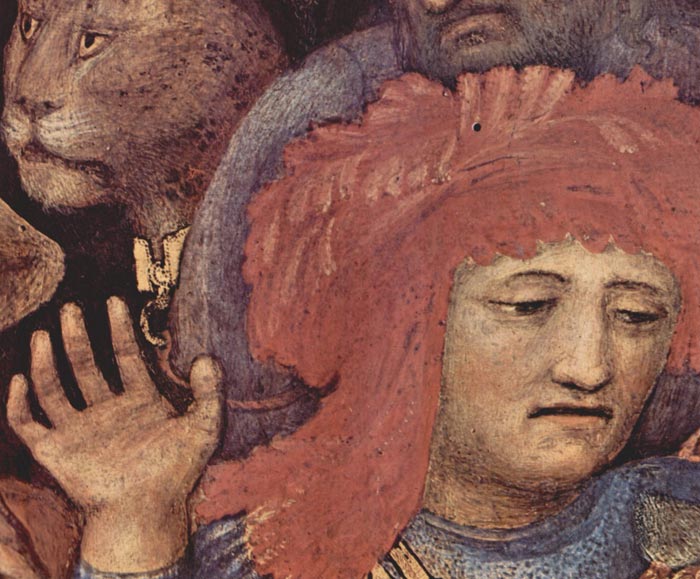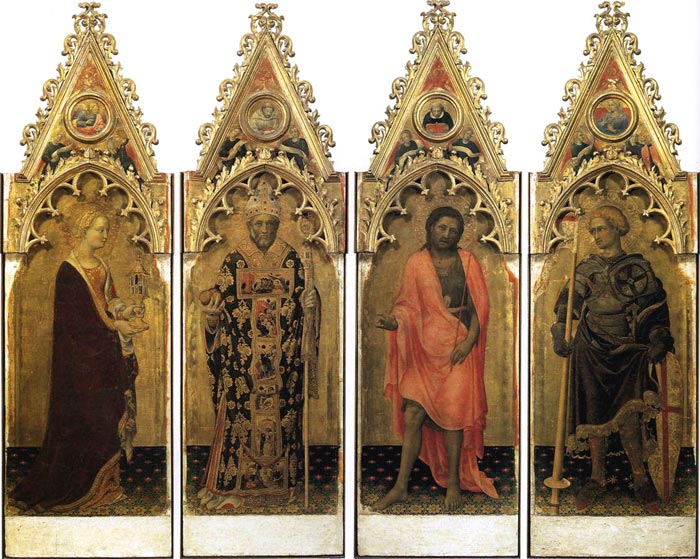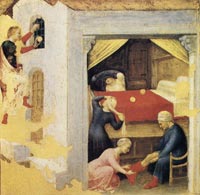| Gentile da Fabriano, Quaratesi Polyptych, 1425 |
Gentile da Fabriano, whose real name was Gentile di Niccolò di Giovanni di Massio, came from Fabriano in the Marches. Typical of Gentile's early style is the polyptych (ca. 1400) from the convent of Valle Romita in Fabriano, in which Gentile displays the International Gothic love for naturalistic detail. In 1409 he was commissioned to decorate the Doges' Palace in Venice with historical frescoes, now lost. His most important fresco cycle, also destroyed, was in the church of St. John Lateran in Rome. His major surviving painting is the celebrated Strozzi Altarpiece (1423), featuring The Adoration of the Magi. Its combination of naturalism and rich ornamentation influenced Italian artists throughout the century, notably Fra Angelico and Benozzo Gozzoli, and established Gentile as one of Italy's greatest proponents of the International Gothic style. He was the most important Italian painter of the first quarter of the 15th century. The polyptych is from the Quaratesi chapel in San Niccolò Soprarno, Florence. The central panel of the polyptych is at the National Gallery, London, and parts of the predella are in the Pinacoteca in Vatican. The four saints represented are Mary Magdalen, Nicholas of Bari, John the Baptist, and George. In the upper tondos supported by angels and cherubs are the Angel Annunciating, St Francis, St Dominic, and the Virgin Annunciate.
|
|
Gentile da Fabriano, Quaratesi Polyptych |
| Despite the fragmentation of this work, the solid figures of these saints demonstrate the way Gentile da Fabriano's painting developed during the time he spent in Florence. Without jeopardizing the grace of his lines or the richness of his materials, the painter seems aware of the strides being made in art around that time by Masolino and Masaccio. The flowering grass of his early work is here replaced by a tiled floor. Each figure is treated with a solemn human and monumental characterization. He achieved this by a more rigorous definition of the volume the figures occupy in real space. But overall it remains thoroughly Gothic in its atmosphere. |
This panel formed the centre of an altarpiece commissioned by a member of the Quaratesi family for the high altar of San Niccoló Oltrarno, Florence. It was flanked by Saints Mary Magdalene, Nicholas of Bari, John the Baptist and George. The predella showed scenes from the Life of Saint Nicholas. The Child holds what seems to be a daisy. The cloth of honour behind the Virgin is silver (now tarnished) glazed with red. The highly decorative nature of the variously patterned luxury textiles, the elaborately tooled gold, and the delicate nature of the figures contrast strongly with the same subject painted by Masaccio a year later. The gable with God the Father is original but within a modern frame. |
||
| This panel belonged to the predella of the dismembered Quaratesi Altarpiece.
It appears that Gentile felt freer to experiment in the minor scenes of a predella than in the main panel of an altarpiece. In the panel Pilgrims at the Tomb of St Nicholas of Bari he shows the interior of a church, which itself was quite a difficult task, with a rather convincing treatment of the space. |
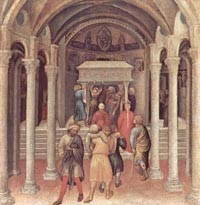 Gentile da Fabriano. The Crippled and Sick Cured at the Tomb of Saint Nicholas, 1425. From the predella of the Quaratesi triptych from San Niccolo, Florence. 1425. Tempera on wood. The National Gallery of Art, Washington |
|
| The scene illustrates the episode in which Nicholas saved three impoverished girls from prostitution by tossing three gold balls through their window one night. Pictures of Nicholas often show three bags of gold next to him, and often these bags have become simply three disks or balls. The Three Gold Balls represent the gold given to provide dowries for the impoverished maidens. Nicholas' gold balls became the pawnbroker's symbol. Sometimes oranges or apples are used to represent the gold. |
||
|
||
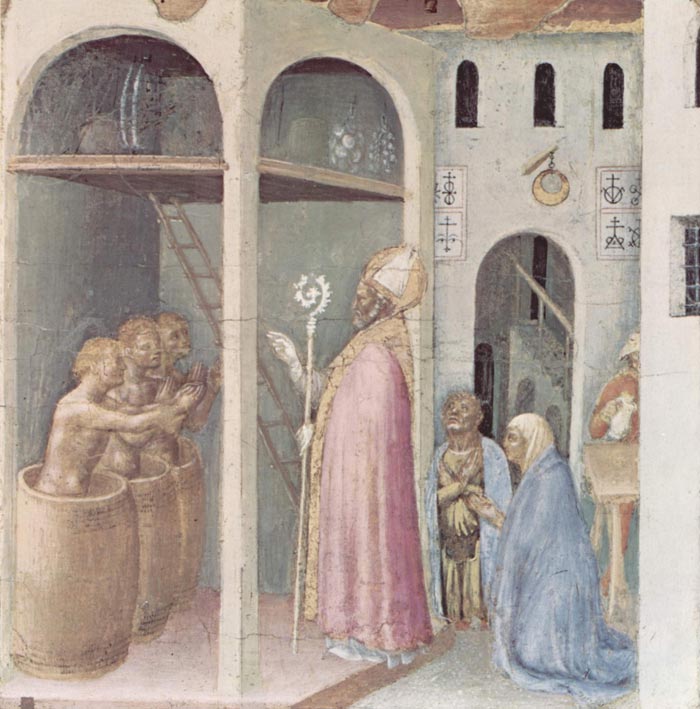 |
||
Gentile da Fabriano, Quaratesi Altarpiece: Quaratesi Polyptych, St. Nicholas Bringing Three Young Men Back to Life, 1425, oil on panel, Pinacoteca, Vatican |
||
Holiday accomodation in Tuscany | Podere Santa Pia | Artist and writer's residency
|
||||
Podere Santa Pia |
Podere Santa Pia, garden view, April |
View from Podere Santa Pia
on the coast and Corsica |
||
 |
||||
Podere Santa Pia situated in panoramic position in the Maremma countryside
|
||||
|
||||
| This page uses material from the Wikipedia article Gentile da Fabriano, published under the GNU Free Documentation License. | ||||

